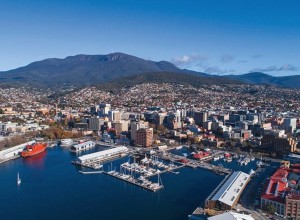There is a lot of excitement around the Tasmanian property market.
While the Apple Isle is projected to deliver strong capital growth, at least in the short-term – making it an attractive destination for investors — there are few things to consider before signing on the dotted line.
With Sydney and Melbourne falling off the radar for many property investors, eyes are turning south across the Bass Strait to Tasmania. 
Significant improvement to employment conditions, low supply of dwellings, low median prices, low vacancy rate and strong rental returns have seen Tasmania deliver solid capital growth in recent years, particularly in 2017.
In fact, The Real Estate Institute of Tasmania’s September 2017 Quarterly Report shows the real estate market on the Apple Isle was the fastest growing in Australia, grossing a whopping $3.8 billion.
Overall house sales rose 7.4 per cent and unit sales a sky-high 24.9 per cent in 2017.
And while it all adds up to exceptionally high-investor serviceability ratio, there are some important considerations investors should take into account before committing to Tasmania.
The research house’s Quarterly Risks & Opportunities Report details seven factors investors should be aware of that have a potential impact on the medium and long-term property market in Tasmania.
1. Houses and units have a completely different risk profile
While in the medium-term the risk of investing in houses is ‘low’, for units this is not the case.
We place the risks associated with units at ‘medium’. This is explained by a number of variables, some of which are highlighted below.
2. Houses enjoy far stronger demand from owner-occupiers
In Hobart 86 per cent of houses are owner-occupied, but only 55 per cent of units.
Houses are also held for a longer period of time, particularly in Hobart, where the average is 10.1 years, as opposed to units that are held for an average of 8.9 years.
The unit market is mainly driven by investors, of which intra-state buyers make up a relatively high proportion, and if there are better opportunities in, say, Melbourne or Sydney, there could be a huge shift and this could have a significant impact on the market.
Tasmania is an extremely small market which means it is much more exposed to external events that reduce intra-state investors demand for housing.
 3. The relative price of unit-to-house in Tasmania is high
3. The relative price of unit-to-house in Tasmania is high
Our research shows that statistically, if the unit-to-house ratio exceeds 65 per cent it makes houses a much better investment option for buyers with significantly higher capital growth. Conversely, if it is below 45 per cent, units are to be preferred.
In Greater Hobart the median unit price is $306,974, while the median house price is $402,859, placing the unit-to-house ratio at 76 per cent.
In the rest of Tasmania, the median unit price is $231,178, while the median house price is $271,248, which means the unit-to-house ratio is even higher at 85 per cent. This is exceptional, and extremely high statistically.
 4. Tasmania, with 210,000 dwellings, is a very small market
4. Tasmania, with 210,000 dwellings, is a very small market
By comparison, there are 256,000 dwellings on the Gold Coast.
Housing prices are high on the agenda of the Liberal Government that has promised to spend $125 million over five years on more affordable housing, stamp duty cuts for first-home buyers, a $20,000 first-home builders grant, tax relief for downsizing retirees and three-year land tax breaks for properties being rented out.
Also, any major Government policy to increase housing supply to address the issue of housing prices, could have a strong adverse impact on the property market, in the medium to long-term, particularly on units.
5. The economic growth in Tasmania is the second lowest in Australia
He said while there was a perception the economy in Tasmania enjoyed strong growth, this was not the case.
Besides Western Australia, Tasmania has the lowest economic growth in the country in terms of Gross State Product (GSP).
6. Median weekly wage and wage growth are the lowest in Australia
While there is a significant improvement in the Tasmanian labour market, the unemployment at 6 per cent is the highest in Australia.
In addition, the annual median income is only $57,200 per household, the lowest in Australia.
This means, that a large proportion of the jobs are low-salary ones. The annual salary growth is also the lowest in the country.
7. Tasmania is less affordable than five of the states and territories (in price-to-income ratio) terms 
Although the median house price in Hobart is only $403,000, dwellings in Tasmania are less affordable, in terms of price-to-income ratio than all states and territories, besides NSW and Victoria.
The reason is the low annual household income.
In conclusion, while there was strong demand and excitement in the Tasmanian property market, a long-term risk-based approach should be taken before departing from hundreds of thousands of dollars.

No comments:
Post a Comment